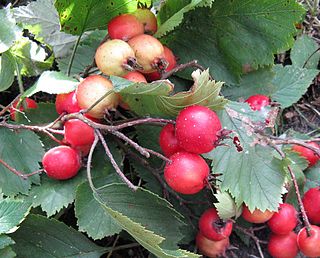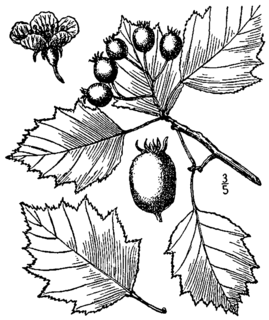
Crataegus, commonly called hawthorn, quickthorn, thornapple, May-tree, whitethorn, or hawberry, is a genus of several hundred species of shrubs and trees in the family Rosaceae, native to temperate regions of the Northern Hemisphere in Europe, Asia, North Africa, and North America. The name "hawthorn" was originally applied to the species native to northern Europe, especially the common hawthorn C. monogyna, and the unmodified name is often so used in Britain and Ireland. The name is now also applied to the entire genus and to the related Asian genus Rhaphiolepis.

Mayhaw is the name given to the fruit of the species of Crataegus series Aestivales that are common in wetlands throughout the southern United States. The principal species are C. aestivalis, the eastern mayhaw, and C. opaca, the western mayhaw.

Crataegus monogyna, known as common hawthorn, one-seed hawthorn, or single-seeded hawthorn, is a species of flowering plant in the rose family Rosaceae. It is native to Europe, northwestern Africa, and West Asia, but has been introduced in many other parts of the world.

Crataegus mollis, known as downy hawthorn or red hawthorn, is a species of plant that occurs in eastern North America from southeastern North Dakota east to Nova Scotia and southwest to eastern Texas. The range of this species is from southern Ontario and Michigan to eastern North Dakota and southward to Denison, Texas, and Arizona. This tree inhabits wooded bottomlands, the prairie border, and the midwest savanna understorey.

Crataegus laevigata, known as the Midland hawthorn, English hawthorn, woodland hawthorn, or mayflower, is a species of hawthorn native to western and central Europe, from Great Britain and Spain east to the Czech Republic and Hungary. It is also present in North Africa. The species name is sometimes spelt C. levigata, but the original orthography is C. lævigata.

Crataegus aestivalis, known as the eastern mayhaw, is a shrub or small tree of the southeastern United States that grows in low-lying or wet areas from eastern Alabama to central Florida and Virginia. It is one of several species of hawthorn with fruits known as "mayhaws", which are harvested for use in making mayhaw jelly, considered a delicacy in many areas of the South. Other species of mayhaws include Crataegus opaca, the western May Hawthorn, which is native from east Texas to Alabama.

Mahonia trifoliolata is a species of flowering plant in the family Berberidaceae, in southwestern North America. Common names include agarita, agrito, algerita, currant-of-Texas, wild currant, and chaparral berry. The name Agarita comes from the Spanish verb agarrar, which means "to grab". The ending "-ita" is often added to little things, so agarita means "grabs a little". This was probably said because the bush is a bit scratchy but does not have significant spines. Typical characteristics are grey-green to blue-grey leaves, yellow flowers in February to April and the red berries appearing in May. The most important harvest organ are the berries, though the roots and seeds can also be used.

Crataegus crus-galli is a species of hawthorn known by the common names cockspur hawthorn and cockspur thorn. It is native to eastern North America from Ontario to Texas to Florida, and it is widely used in horticulture. It is thought to be the parent, along with Crataegus succulenta, of the tetraploid species Crataegus persimilis.

Crataegus pruinosa is a species of hawthorn known by the common name frosted hawthorn. It is native to a wide area of the eastern United States and southern Canada, and is sometimes considered to be several species, rather than just one.

Crataegus submollis, known as the northern downy hawthorn, northern red haw, Quebec hawthorn, or hairy cockspurthorn, is a species of hawthorn that grows to about 7 m in height and typically carries large crops of red fruit.

Crataegus mexicana is a species of hawthorn known by the common names tejocote, manzanita, tejocotera and Mexican hawthorn. It is native to the mountains of Mexico and parts of Guatemala, and has been introduced in the Andes. The fruit of this species is one of the most useful among hawthorns.
Crataegus iracunda, with common name passionate hawthorn, and sometimes called the stolon-bearing hawthorn is a North American species of hawthorn. It was described in 1899 by Chauncey Delos Beadle of the Biltmore Herbarium in North Carolina. Taxonomic opinions have differed about this species, and to complicate matters Crataegus macrosperma and various species of C. series Populneae have frequently been misidentified as C. iracunda, leading to differing statements about its geographic range. The 2015 Flora of North America considers its range to be in the southeastern U.S., restricted to the US states of Alabama, Georgia, Louisiana, Mississippi, North Carolina, South Carolina, and Virginia.
Crataegus visenda is a species of hawthorn from the southeastern United States, in Alabama, Florida, and Georgia. It is a large shrub or small tree to 10 m tall. It has been considered as a synonym of Crataegus flava Aiton
Crataegus rufula, or Crataegus × rufula, known as the rusty hawthorn or rufous mayhaw, is a shrub or small tree of the south eastern United States. It is one of several species of hawthorn with fruits known as "mayhaws", which are harvested for use in making mayhaw jelly. It is thought to be a hybrid between the other two species of mayhaw.
Crataegus texana, the Texas hawthorn, is a member of the family Rosaceae. Typically, it is found in the form of a small tree or a large shrub and blooms in early spring, usually in the months of March and April. Flowers of the Texas Hawthorn are white and usually produce small, one-inch, scarlet fruits that are said to resemble tiny red apples. Its twigs are usually armed with thorns that can grow to be about one to three inches long.

Crataegus pennsylvanica, known as the Pennsylvania thorn, is a species of hawthorn native to Delaware, New York, North Carolina, Ontario, Ohio, and Pennsylvania, that grows to about 8 m in height. The mature trees have few thorns.

Series Molles is a series within the genus Crataegus that contains at least six species of hawthorn trees and shrubs, native to Eastern North America. Some of the species are cultivated as ornamental plants. They have relatively large leaves, large flowers, and bloom early for hawthorns. The plant parts are usually hairy, particularly in early growth, and the fruit are generally red and are large for hawthorn fruit.
Series Populneae is a series within the genus Crataegus that contains at least eight species of hawthorn trees and shrubs, native to Eastern North America. Only one species, C. populnea is widespread.
Series Pruinosae is a series within the genus Crataegus that contains at least six species of hawthorn trees and shrubs, native to Eastern North America. They are similar in some respects to series Intricatae. They are very thorny, with medium to large leaves, and hard fruit that are usually pinkish in colour.

Series Tenuifoliae is a series within the genus Crataegus that contains at least seven species of hawthorn trees and shrubs, native to Eastern North America, with one disjunct species in the mountains of New Mexico.













